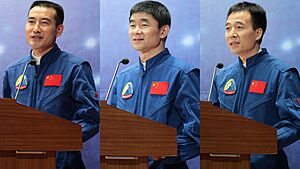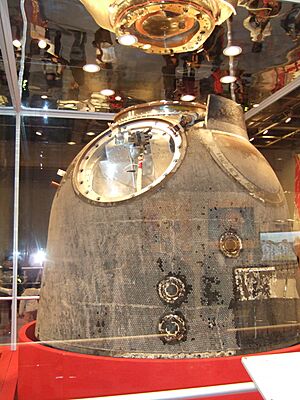Shenzhou 7 facts for kids

Shenzhou 7 spacecraft model
|
|
| Mission duration | 2 days, 20 hours, 27 minutes |
|---|---|
| Spacecraft properties | |
| Spacecraft type | Shenzhou |
| Crew | |
| Crew size | 3 |
| Members | Zhai Zhigang Liu Boming Jing Haipeng |
| EVAs | 1 |
| EVA duration | 22 minutes |
| Start of mission | |
| Launch date | 25 September 2008, 13:10:04.988 UTC |
| Rocket | Long March 2F |
| Launch site | Jiuquan LA-4/SLS-1 |
| End of mission | |
| Landing date | 28 September 2008, 09:37 UTC |
| Landing site | Siziwang Banner Central Inner Mongolia |
| Orbital parameters | |
| Reference system | Geocentric |
| Regime | Low Earth |
 Zhai, Liu and Jing Shenzhou missions
|
|
Shenzhou 7 (simplified Chinese: 神舟七号; traditional Chinese: 神舟七號; pinyin: Shénzhōu Qī Hào) was the third time China sent people into space. This mission was super important because it included China's first ever spacewalk (also called an EVA). Astronauts Zhai Zhigang and Liu Boming performed this spacewalk. It marked the start of a big new phase for China's space program.
The Shenzhou spacecraft carried three astronauts. It launched on September 25, 2008, using a Long March 2F rocket. The rocket lifted off from the Jiuquan Satellite Launch Center. The mission lasted three days. The spacecraft landed safely in Siziwang Banner in central Inner Mongolia on September 28, 2008. With this spacewalk, China became only the third country to have an astronaut walk in space. Before China, only the Soviet Union (now Russia) and the United States had done spacewalks.
Contents
Meet the Astronauts
The names of the astronauts for Shenzhou 7 were shared on September 17, 2008.
| Position | Crew Member | |
|---|---|---|
| Commander | Zhai Zhigang First spaceflight |
|
| Orbital module astronaut | Liu Boming First spaceflight |
|
| Descent module monitor astronaut | Jing Haipeng First spaceflight |
|
Backup Crew Members
There was also a backup crew ready to go if needed.
| Position | Crew Member | |
|---|---|---|
| Commander | Chen Quan (陈全) | |
| Orbital module astronaut | Fei Junlong (费俊龙) | |
| Descent module monitor astronaut | Nie Haisheng (聂海胜) | |
Only Chen Quan from the backup crew had not flown in space before.
Mission Highlights
Shenzhou 7 was China's first space mission to carry three people for several days. It was also the first to complete a full set of operations. Six astronauts were trained for this mission. Three were chosen for the flight, and three were backups.
The Long March 2F rocket launched Shenzhou 7 into orbit on September 25, 2008. After three days in space, the spacecraft began its return to Earth. It landed safely on September 28, 2008. Many world leaders congratulated China on this successful mission. It marked many new achievements for China's space program.
The Shenzhou 7 Mission won a special award in 2009. It received the Space Achievement Award from the Space Foundation.
The Amazing Spacewalk
On September 27, astronaut Zhai Zhigang made history. He wore a special Chinese-made Feitian space suit. He performed a 22-minute spacewalk, the first ever for a Chinese astronaut! Zhai floated out of the orbital module. He moved around the outside, collected some experiment samples, and waved the Chinese flag. The spacewalk lasted about 20 minutes. Zhai then returned to the orbital module.
This first spacewalk was carefully planned. Cables kept Zhai safe and close to the spacecraft. His path was limited to areas near the exits. Liu Boming wore a Russian Orlan-M suit. He stayed in the airlock to help Zhai if needed. Liu also briefly stood up in the airlock to hand Zhai a flag. The third astronaut, Jing Haipeng, stayed inside the main part of the spacecraft. He watched over the mission from inside. The spacewalk was shown live on Chinese TV. Two cameras gave a wide view of the event.
The Feitian spacesuit is similar to the Russian Orlan-M suit. It is designed for spacewalks lasting up to seven hours. It provides oxygen and handles waste. Reports said each suit cost about US$4.4 million. Most parts of the suits were not brought back to Earth.
A fire alarm went off at the start of the spacewalk. But it was quickly confirmed to be a false alarm.
Space Experiment: Solid Lubricant
Scientists did an experiment with a special solid lubricant. A piece of equipment, about the size of a book, was placed outside the orbital module. Astronaut Zhai Zhigang retrieved it during his spacewalk. It had been exposed to space for over 40 hours. This experiment helps scientists learn about lubricants. These lubricants will be used for moving parts on future space stations.
Releasing a Mini Satellite
A small satellite was released during the mission. This happened on September 27, after Zhai returned to the spacecraft. The satellite was a cube, about 40 cm (16 inches) long. It weighed 40 kg (88 lb). It had small engines and two powerful cameras.
The satellite had several jobs. It tested new mini-satellite technology. It also watched and took pictures of the Shenzhou 7 spacecraft. It helped test how to track and approach other objects in space. This is important for future space meetings and docking. The mini-satellite took photos and videos near the spacecraft. Then it moved far away. After the main spacecraft returned to Earth, the satellite used a special engine to catch up. It continued to orbit around the spacecraft for about three months.
Data Relay Satellite
China launched its first data relay satellite in April 2008. It was called Tianlian I. This satellite helped Shenzhou 7 communicate with ground stations. It allowed more data to be sent to Earth faster. The Tianlian I satellite could cover 50 percent of Shenzhou 7's orbit. This greatly increased the total communication coverage for the mission.
Mission Support and Preparation
The Shenzhou 7 project had seven main parts. The Chinese military handled the launch, recovery, crew, and tracking. The China Aerospace Science and Technology Corporation built the rocket and spacecraft. The Chinese Academy of Sciences was in charge of the scientific tools on board.
Water Training Pool
Astronauts trained in a large water pool. It was 23 meters (75 feet) wide and 10 meters (33 feet) deep. This pool helped them practice spacewalks. It made them feel like they were weightless in space. A model of the Shenzhou orbital module was used in the pool for training.
Rocket Improvements
Engineers made improvements to the Long March 2F rocket. They fixed vibration problems that happened during earlier missions. These changes made the ride smoother for the astronauts.
Spacecraft Changes
The Orbital module of the spacecraft was changed for the spacewalk. Its solar panels were removed. Handrails were added to the outside. These helped the astronaut move around during the spacewalk. More cameras were also installed on this spacecraft.
New Tracking Ships
Two new tracking ships, Yuanwang-5 and Yuanwang-6, helped a lot. These ships played a key role in tracking the Shenzhou 7 mission.
See also
- Chinese space program
- Tiangong program
- Jiuquan Satellite Launch Center
- Long March 2F Rocket
- Voskhod 2, first spacewalk mission
- Gemini 4, first US spacewalk mission
- Voskhod 1, first 3-person crew mission
- Soyuz 5, first 3-person crew mission with EVA


